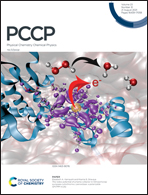Reduction of N2 to NH3 by TiO2-supported Ni cluster catalysts: a DFT study†
Abstract
Electrochemical techniques for ammonia synthesis are considered as an encouraging energy conversion technology to efficiently meet the challenge of nitrogen cycle balance. Herein, we find that TiO2(101)-supported Ni4 and Ni13 clusters can serve as efficient catalysts for electrocatalytic N2 reduction based on theoretical calculations. Electronic property calculations reveal the formation of electron-deficient Ni clusters on the TiO2 surface, which provides multiple active sites for N2 adsorption and activation. Theoretical calculation identifies the strongest activated configuration of N2* on the catalysts and confirms the potential-limiting step in the nitrogen reduction reaction (NRR). On Ni4–TiO2(101), N2* → NNH* is the potential-limiting step with a very small free energy increase (ΔG) of 0.24 eV (the corresponding overpotential is 0.33 V), while on Ni13–TiO2(101) the potential-limiting step occurs at NH* → NH2* with ΔG of 0.49 eV (the corresponding overpotential is 0.58 V). Moreover, the Nin–TiO2(101) catalyst, especially Ni13–TiO2(101), involves in a highly selective NRR even at the corresponding NRR overpotential. This work will enlighten material design to construct metal oxide supported transition metal clusters for the highly efficient NRR and NH3 synthesis.



 Please wait while we load your content...
Please wait while we load your content...